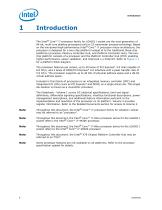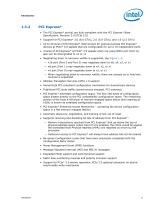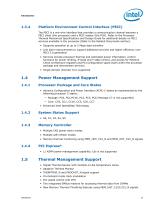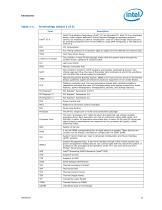
Catalog excerpts

Intel® Core™ i7 Processor Family for LGA2011 Socket Datasheet – Volume 1 of 2 Supporting Desktop Intel® Core™ i7-4960X Extreme Edition Processor Series for the LGA2011 Socket Supporting Desktop Intel® Core™ i7-49xx and i7-48xx Processor Series for the LGA2011 Socket
Open the catalog to page 1
By using this document, in addition to any agreements you have with Intel, you accept the terms set forth below. INFORMATION USE OF INTEL PRODUCTS INCLUDING CONNECTION WITH Intel® PRODUCTS. TO FITNESS FOR A PARTICULAR PURPOSE, MERCHANTABILITY, OR INFRINGEMENT OF ANY PROPERTY RIGHTS ISOR OTHER INTELLECTUAL PROPERTY RIGHT. PROVIDED IN INTEL'S TERMS AND CONDITIONS OF SALE FOR SUCH PRODUCTS, INTEL ASSUMES NO LIABILITY WHATSOEVER, AND INTEL DISCLAIMS ANY Express* OR IMPLIED WARRANTY, RELATING TO SALE AND/OR IN THIS DOCUMENT IS PROVIDED IN LIABILITY OR WARRANTIES RELATING NO LICENSE, Express* OR...
Open the catalog to page 2
Revision History Revision Number 001 002 Initial release Chapter , "1 Introduction 9," — Section 1.3.1, “System Memory Support” corrected DDR3 DRAM technologies supported
Open the catalog to page 7
Introduction The Intel® Core™ i7 processor family for LGA2011 socket are the next generation of 64-bit, multi-core desktop processors built on 22-nanometer process technology. Based on the low-power/high-performance Intel® Core™ i7 processor micro-architecture, the processor is designed for a two-chip platform instead of to the traditional three-chip platforms (processor, Memory Controller Hub, and Platform Controller Hub). The twochip platform consists of a processor and the Platform Controller Hub (PCH) enabling higher performance, easier validation, and improved x-y footprint. Refer to...
Open the catalog to page 8
Processor Platform Block Diagram Example Processor Feature Details • Up to 6 execution cores • Each core supports two threads (Intel® Hyper-Threading Technology), up to 12 threads per socket • 32KB instruction and 32-KB data first-level cache (L1) for each core • 256KB shared instruction/data mid-level (L2) cache for each core • Up to 15MB last level cache (LLC): up to 2.5MB per core instruction/data last level cache (LLC), shared among all cores
Open the catalog to page 9
Supported Technologies • Intel® Virtualization Technology (Intel® VT) • Intel® Virtualization Technology (Intel® VT) for Directed I/O (Intel® VT-d) • Intel® Virtualization Technology (Intel® VT) Processor Extensions • Intel® 64 Architecture • Intel® Streaming SIMD Extensions 4.1 (Intel® SSE4.1) • Intel® Streaming SIMD Extensions 4.2 (Intel® SSE4.2) • Intel® Advanced Vector Extensions (Intel® AVX) • Intel® AVX Floating Point Bit Depth Conversion (Float 16) • Intel® Hyper-Threading Technology • Execute Disable Bit • Intel® Turbo Boost Technology • Enhanced Intel® SpeedStep® Technology System...
Open the catalog to page 10
PCI Express* • The PCI Express* port(s) are fully-compliant with the PCI Express* Base Specification, Revision 3.0 (PCIe 3.0) • Support for PCI Express* 3.0 (8.0 GT/s), 2.0 (5.0 GT/s), and 1.0 (2.5 GT/s) • Up to 40 lanes of PCI Express* interconnect for general purpose PCI Express* devices at PCIe* 3.0 speeds that are configurable for up to 10 independent ports • 4 lanes of PCI Express* at PCIe* 2.0 speeds when not using DMI2 port (Port 0), also can be downgraded to x2 or x1 • Negotiating down to narrower widths is supported, see Figure 1-2: — x16 port (Port 2 and Port 3) may negotiate down...
Open the catalog to page 11
PCI Express* Lane Partitioning and Direct Media Interface Gen 2 (DMI2) Port 0 DMI / PCIe Direct Media Interface Gen 2 (DMI2) • Serves as the chip-to-chip interface to the PCH • The DMI2 port supports x4 link width and only operates in a x4 mode when in DMI2 • Operates at PCI Express* 1.0 or 2.0 speeds • Transparent to software • Processor and peer-to-peer writes and reads with 64-bit address support • APIC and Message Signaled Interrupt (MSI) support. Will send Intel-defined “End of Interrupt” broadcast message when initiated by the processor. • System Management Interrupt (SMI), SCI, and...
Open the catalog to page 12
Platform Environment Control Interface (PECI) The PECI is a one-wire interface that provides a communication channel between a PECI client (the processor) and a PECI master (the PCH). Refer to the Processor Thermal Mechanical Specifications and Design Guide for additional details on PECI services available in the processor (Refer to the Related Documents section). • Supports operation at up to 2 Mbps data transfers • Link layer improvements to support additional services and higher efficiency over PECI 2.0 generation • Services include processor thermal and estimated power information,...
Open the catalog to page 13
Package Summary The processor socket type is noted as LGA2011. The processor package is a 52.5 x 45 mm FC-LGA package (LGA2011). Refer to the Processor Thermal Mechanical Specification and Design Guide (see Related Documents section) for the package mechanical specifications. Terminology (Sheet 1 of 3) Term ACPI Description Advanced Configuration and Power Interface Active State Power Management Continuous Conduction Mode Discontinuous Conduction Mode Third generation Double Data Rate SDRAM memory technology that is the successor to DDR2 SDRAM Direct Memory Access Direct Media Interface...
Open the catalog to page 14
Terminology (Sheet 2 of 3) Term Intel® Virtualization Technology (Intel® VT) for Directed I/O. Intel VT-d is a hardware assist, under system software (Virtual Machine Manager or operating system) control, for enabling I/O device virtualization. Intel VT-d also brings robust security by providing protection from errant DMAs by using DMA remapping, a key feature of Intel VT-d. Any timing variation of a transition edge or edges from the defined Unit Interval (UI). Joint Test Action Group The LGA2011-0 land FCLGA package mates with the system board through this surface mount, LGA2011-0 contact...
Open the catalog to page 15All Intel catalogs and technical brochures
-
10th Gen Intel® Core
7 Pages
-
10th Gen
8 Pages
-
nuc-celeron
4 Pages
-
Intel® NUC 8 Home Mini PC
4 Pages
-
Intel® Xeon® Scalable Platform
14 Pages
-
Intel® Ethernet Controller XL710
1726 Pages
-
Intel® Xeon® Processor E3-1200 v5
130 Pages
-
Intel® Quark™ SoC X1000 Series
934 Pages
-
Intel® X99 Chipset
4 Pages
-
Intel® Desktop Board DQ67EP
4 Pages
-
Intel® Ethernet Switch FM4000
270 Pages
-
Intel® NUC Board DE3815TYBE
82 Pages
-
S2600GZ and S2600GL
245 Pages
-
i7-lga2011
314 Pages
-
c600-series
936 Pages
-
b75-express
4 Pages
-
desktop-board
4 Pages
-
3rd-gen-core-desktops
2 Pages
-
/3rd-gen-core
2 Pages
Archived catalogs
-
Intel® Ethernet Controllers
2 Pages
-
Intel® 3450 Chipset
2 Pages
-
Intel® 3000 and 3010 Chipset
4 Pages
-
Intel® X58 Express Chipset
4 Pages
-
Intel® Server Board S1200BT
8 Pages
-
Intel® Desktop Board DX58SO2
4 Pages































































